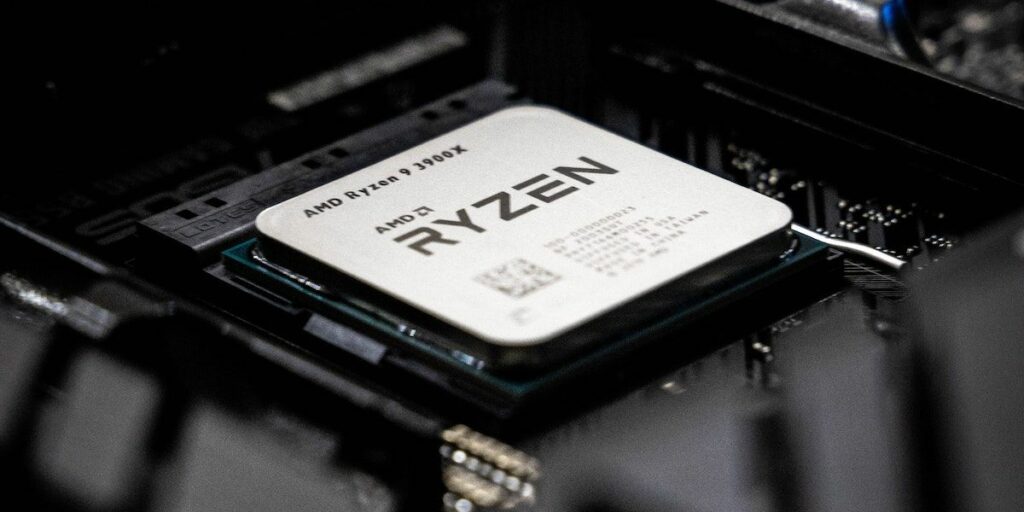AMD’s 3D V-Cache technology has the potential to leapfrog Intel in gaming performance and transform the CPU market. But what’s the big deal?
The Ryzen 7 5800X3D CPU was one of AMD’s many announcements at CES 2022, yet it went virtually ignored. Despite the fact that it was still a Zen 3 product, which Intel’s Alder Lake had dethroned, AMD claimed that its new device was the fastest gaming CPU on the market. And also handily outperforming even Intel’s most recent products in terms of frame rates.
The company attributes its achievement to its innovative 3D V-Cache technology, which has 96MB of L3 cache in the new chip. But how does AMD’s 3D V-Cache function? And how does it improve the gaming experience? Let us investigate.
How Does AMD’s 3D V-Cache Work?
Before we get into how 3D V-Cache works, it’s important to understand how L3 cache works in general.
There are three layers of CPU cache in a CPU: L1, L2, and L3. The key distinction between levels is speed and capacity: L1 is the smallest but also the fastest, while L3 is much slower but also the largest. L3, as the largest, serves as the lowest level.
Consider the L3 cache to be a generic memory pool where the CPU can store instructions and the L2/L1 caches can retrieve or transfer information as needed. The larger the memory pool (L3), the more instructions the CPU can store concurrently and quickly retrieve, and the faster it can execute those instructions.
This is where 3D V-Cache enters the picture.
You may have noticed that ordinary Zen 3 chips have up to 32MB of L3 cache while double-die chips, like as the Ryzen 9 5900X, have up to 64MB. This is already quite large, but what if it was even bigger?
AMD initially announced 3D V-Cache last year, demonstrating the technology on a Ryzen 9 prototype with 192MB of L3 cache. This Ryzen 7 5800X3D will be the first commercial device to use this technology, with 96MB of L3 cache, which is still extremely outstanding.
The “3D” branding already gives it away. It works by stacking multiple levels of cache on top of one another, effectively increasing the amount of cache available to the CPU at any given time. This manner, you can upgrade from the basic 32MB of the Ryzen 7 5800X to the 96MB of the 5800X3D.
How Does 3D V-Cache Help in Gaming?

It may be beneficial, however not to the extent that AMD depicts.
Having extra L3 cache is not something that will improve every workload. After all, computers perform a variety of functions. While AMD normally excels at productivity tasks, this particular chip set touts advances in the gaming section specifically.
When the CPU needs to process many instructions, the enlarged L3 cache helps since instructions may store directly in the CPU and fetch from there rapidly instead of being drawn from RAM.
Gaming is one example of a workload that can benefit from a large L3 cache. In games, the CPU must handle a variety of instructions quickly. The more instructions that can retrieve from the CPU rather than RAM, the better.
5800X3D compared to the regular 5800X
The L3 cache on the 5800X3D is practically three times larger than on the normal 5800X, thanks to 3D V-Cache technology. As a result, it can store three times as many instructions, which the CPU can execute faster and more efficiently. This could result in improved performance and frame rates, particularly for CPU-intensive games like Counter-Strike: Global Offensive.
Despite being much newer, AMD claims that the Ryzen 7 5800X3D can compete with Intel’s Alder Lake processors. And it’s all because to 3D V-Cache. At least according to AMD’s official figures. The company claims a 17 percent frame rate advantage in Final Fantasy XIV over the Intel Core i9-12900K, which, if true, is amazing given how the 12th-gen CPU has already surpassed the ordinary 5800X.
We have no way of verifying these stats until the CPU is released, as more scientific testing would require to give a clearer image of which product is genuinely better in gaming. One thing to keep in mind is that AMD measured these values at 1080p in-game resolution. As the resolution grows up, the frame rate baton gradually transfer to the GPU.
Should I Get A 3D V-Cache-Equipped CPU?

For me, the answer is to wait until the 5800X3D is on store shelves and in the hands of independent reviewers before forming conclusions. We’re not saying AMD is lying. This may conceivably be the finest gaming CPU on the market until Zen 4 or Raptor Lake take over later this year.
Any company would plainly provide good stats, and it never hurts to do your own research, especially when it involves something as expensive as your gaming PC.
The prospects for AMD’s 3D V-Cache technology are highly exciting. We’ll certainly learn more about it when Ryzen 7000 CPUs with the Zen 4 architecture hit shop shelves later this year. But is this the certain Intel killer that the firm has been seeking for, or will Intel come up with anything to retaliate against AMD? Time will only tell.
AMD’s 3D V-Cache Might Live Up To The Hype
AMD’s claims make sense in this context. More L3 cache has the potential to significantly increase gaming performance, as long as the correct games and workloads use. CPU-intensive games such as Counter-Strike: Global Offensive and League of Legends would most likely benefit the most. However, the picture becomes murkier in more graphically intensive games.
For the time being, all we know is that the desktop CPU market is heating up again, and we’re all for it. After all, competition leads to innovation, which leads to positive things for customers in some way.
Read more: What is a Browser Cache? How Do I Clear It?
